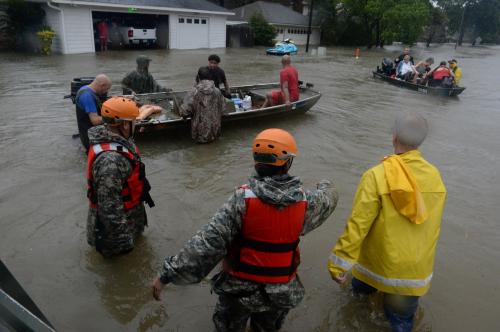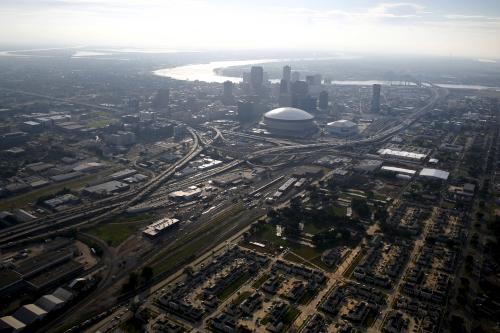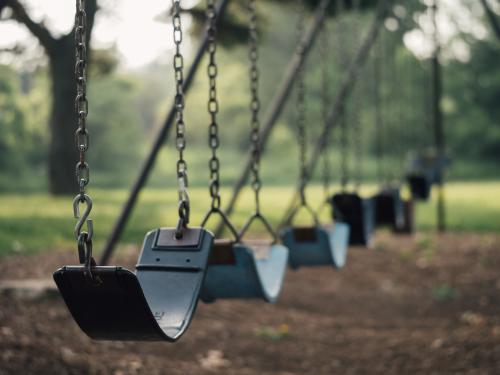Hurricane Harvey made landfall and dumped torrential rains that inundated Houston in the same week Hurricane Katrina encroached New Orleans 12 years ago. As a former resident of New Orleans, the last week in August since 2005 has been difficult. Seeing footage of Harvey is an intimate retelling of the pain caused by Katrina for many from the Gulf, including Houstonians who also felt its consequences. My heart goes out to those impacted and to those who have lost their lives, with at least nine deaths attributed to Harvey so far.
I want to say that I’m focused on what’s transpiring in Houston, but it’s hard not to connect these two devastating natural disasters, reflecting upon the immediate aftermath of Katrina and New Orleans’ ensuing struggles to rebuild, while contemplating Houston’s future.
The water will subside
Brick by brick, local folk will rebuild. As residents toil drying out, salvaging mementos and determining if they’re covered by insurance, they must prepare for the manmade storms that could follow. Being excluded from recovery processes can feel like another tragedy that can continue for months. It’s difficult to see where rescue and recovery begins and ends. But eventually, Houston will prioritize making the city more capable of withstanding the next inevitable storm.
But rebuilding Houston as a stronger, more resilient city must mean making its recovery inclusive.
Katrina’s ten-year anniversary estimates found the federal government spent approximately $120 billion on hurricane Katrina related recovery projects, which is more than three times the annual budget of Louisiana. Certainly, across many indicators, New Orleans is “better.” She has a rebuilt levee system, new school facilities and the city’s tourism is thriving once again. But the city needed to adapt in ways that would address what helped make Katrina the greatest disaster in U.S. history: an economy fueled by low-wage work and undesirable public systems that could not uplift a chronically poor, underemployed black community.
Federal recovery dollars can provide a short-term boost for an economy, but it takes creative planning to have those dollars churn sustained economic growth. The hammers and shovels used in recovery must be replaced with tools suited for higher-skilled jobs in the next economy. After an initial bump in high-paying jobs, the annual rate of job growth slowed between 2010-2014 in New Orleans, and most (seven of 10) of the jobs added came from low-wage industries like tourism, administrative services, and retail, according to a Brookings analysis. Ten years after Katrina, poor black people were as poor (read vulnerable) as they were before the storm. This is after approximately 33,000 low-income residents did not return.
Without a deliberate, strategic effort to include those already left out of the labor market, residents will not benefit from recovery efforts in the short or long-term.
A tale of two disasters
Houston and New Orleans are two very different cities. Harris County, which holds Houston as its county seat, is ranked as the nation’s third most populated county with more than 4.6 million residents. It’s also one of the most diverse labor forces with 32 percent white, 19 percent black, and 7 percent Asian, with the plurality of Latinos at 41 percent. The unemployment rate of 4 percent is slightly below the national average of 4.3 percent.
New Orleans, however, is synonymous with a much smaller Orleans Parish (approximately 391,000 residents). It’s also a majority-minority city, with a 59 percent black and 31 percent white population breakdown. The 5.4 percent unemployment rate is comparably higher in New Orleans, and that doesn’t include the 44 percent of black men who aren’t in the labor force.
While Houston has a lower proportion of people in poverty, they have many more people actually in poverty. Houston’s robust economy provides a solid foundation, but the stakes are just as high in confronting this natural disaster as it was in New Orleans with Katrina. Kevin Simmons, disaster economist at Austin College, told ProPublica the financial losses “will likely exceed Katrina.” Simmons based these losses on a conservative estimate of a 10 percent hit to the $325 billion in residential value and $471 billion local GDP.
Rebuilding, inclusively
When floodwater is in front of you, it’s hard to look ahead, but the framing of recovery dictates its pursuits. Those who have the discretionary time and resources to set the agenda moving forward will, but “recovery” shouldn’t be done to the most vulnerable residents. They must be a part of it. No one should shy away from pursuing opportunities to improve upon the city’s strengths, but everyone must envision job prospects, training and capacity building for the people who need it most. If not, Houston may lose tens of thousands of people who made her great, and it will be less likely for low-income residents to stay in the area for the long haul.
Researchers and commentators will naturally compare the two cities. We will be able to properly assess the damage when the water subsides in Houston and New Orleans. Sadly, on this 12th anniversary of Katrina, New Orleans expects flooding from storms caused by Harvey. As a reminder of the challenges that New Orleans still faces, the city’s complicated pumping and drainage system failed earlier this month, flooding hundreds of homes and businesses. New Orleans is still trying to learn the lesson of Katrina. Let’s hope everyone keeps in mind the lesson on rebuilding with inclusion.






Commentary
New Orleans is still learning from the lessons of Katrina – Houston should too
August 29, 2017